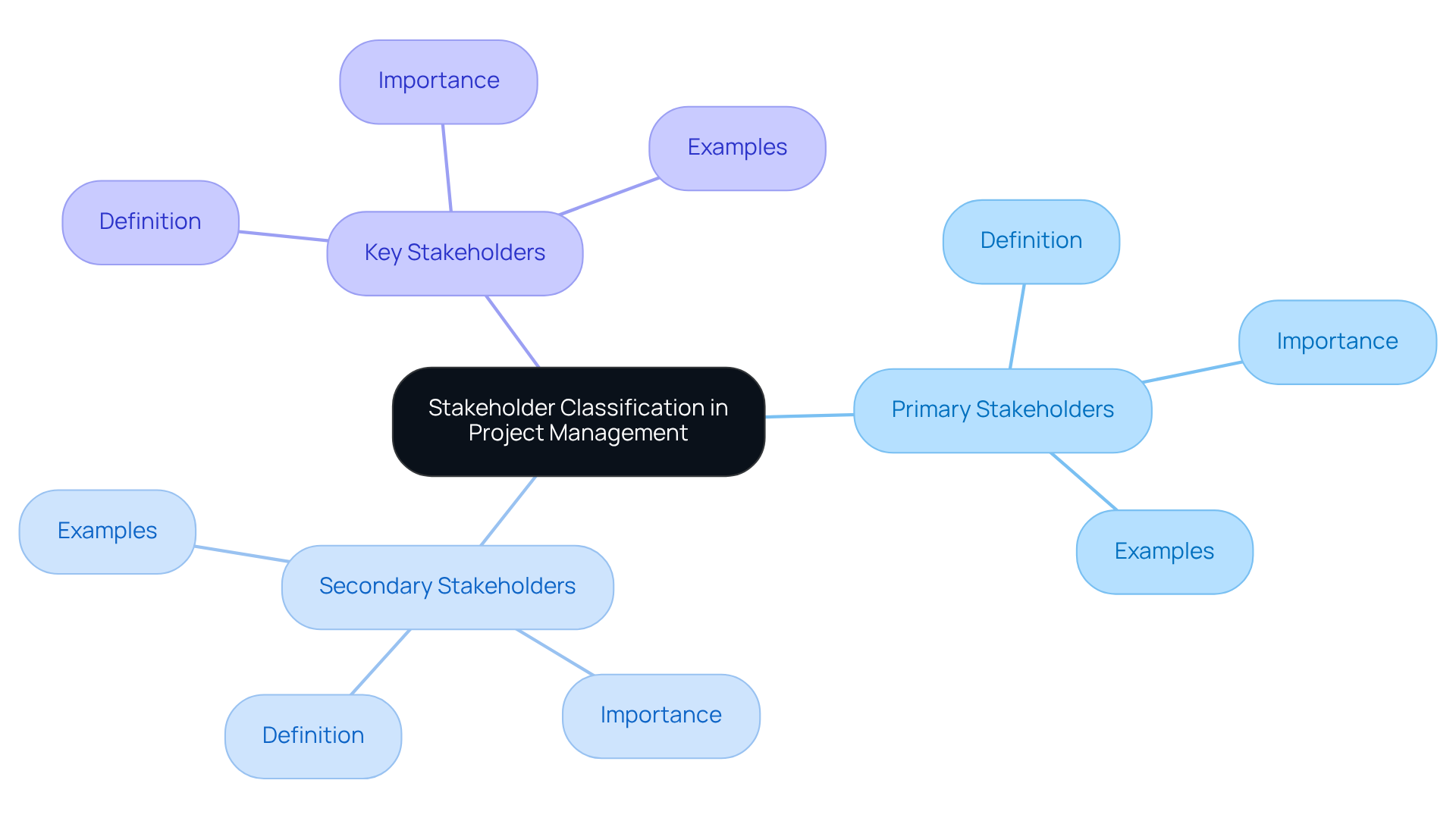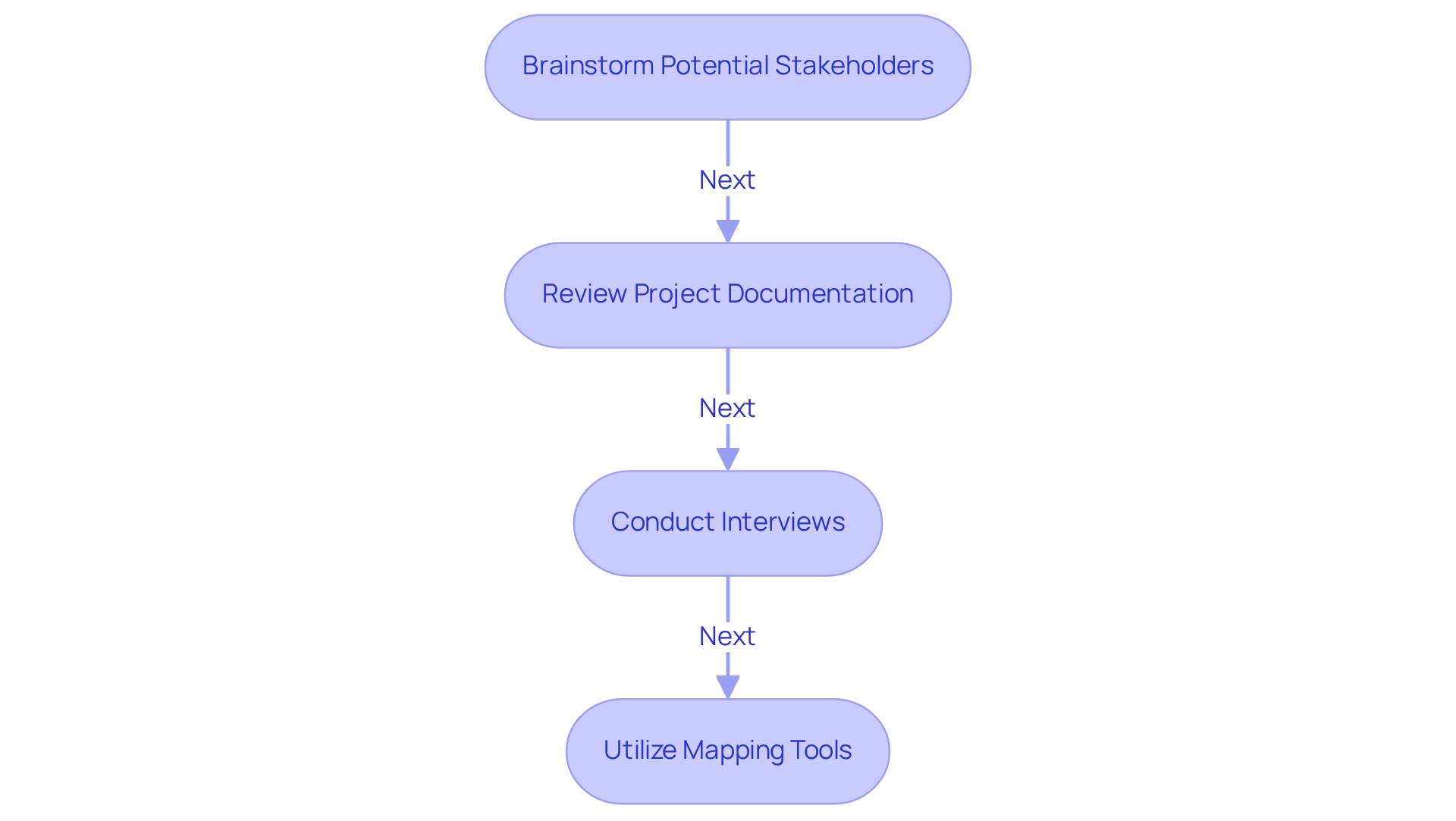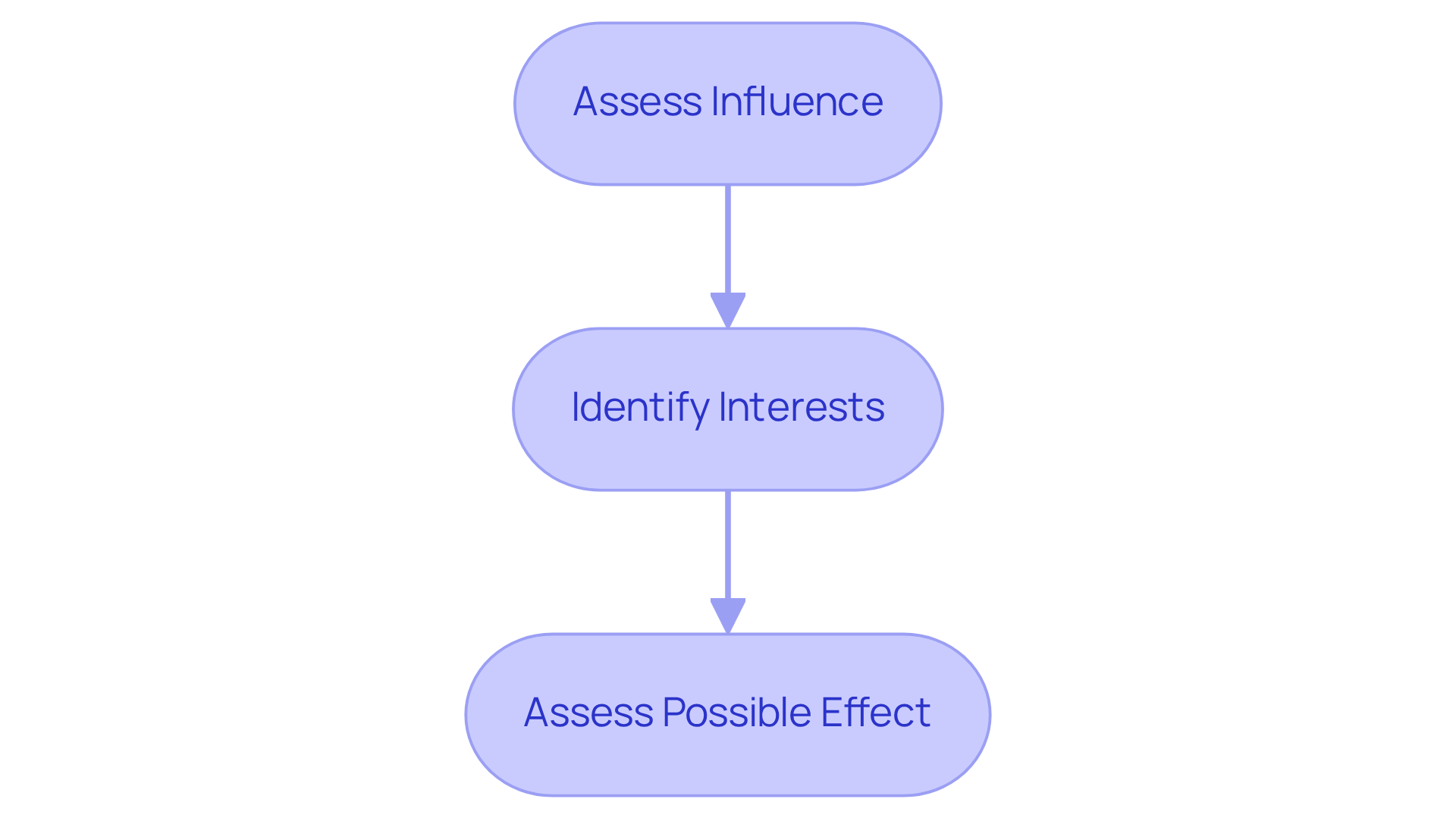Overview
The primary focus of this article is to delineate the essential steps for effective stakeholder classification in project management. Systematic stakeholder classification is not merely beneficial; it is crucial for comprehending their influence and interests. This understanding significantly enhances project engagement and success rates. Indeed, statistics reveal that organizations with robust stakeholder involvement are markedly more likely to achieve their objectives. Therefore, it is imperative to prioritize stakeholder classification to drive project success.
Introduction
Stakeholder classification stands as a pivotal yet frequently neglected element of project management, possessing the potential to profoundly impact the success of any initiative. By systematically categorizing stakeholders according to their interests and influence, project managers can craft tailored engagement strategies that foster collaboration and drive results.
However, a pressing challenge arises: how can one effectively identify and prioritize stakeholders to ensure that their diverse needs are met while maintaining project momentum?
This article explores a structured approach to stakeholder classification, presenting actionable steps that promise enhanced communication, reduced delays, and ultimately, project success.
Define Stakeholder Classification and Its Importance
The process of stakeholder classification in project management involves systematically grouping individuals or collectives based on their connection to the initiative, their influence, and their interests. This stakeholder classification in project management is vital as it enables managers to understand the dynamics at play and effectively prioritize their engagement efforts. By using stakeholder classification in project management to identify the various types of stakeholders—primary, secondary, and key—project managers can craft targeted strategies that address the specific needs and concerns of each group. This foundational understanding is essential for fostering collaboration and ensuring success.
- Primary Stakeholders: Directly affected by the project outcomes.
- Secondary Stakeholders: Indirectly impacted or have a stake in the initiative.
- Key Stakeholders: Have significant influence over initiative decisions and outcomes.
By utilizing stakeholder classification in project management, project leaders can allocate resources more efficiently and tailor communication approaches, ultimately leading to more effective involvement and the success of the endeavor. Research indicates that organizations with robust engagement from interested parties are 30% more likely to achieve their objectives. Furthermore, 85% of initiatives with high levels of stakeholder engagement met or exceeded their initial aims and targets. Involving participants early in the initiative lifecycle fosters teamwork and commitment, ultimately driving successful outcomes.
As Benjamin Franklin wisely stated, "If you fail to plan, you are planning to fail!" This underscores the necessity of planning in management, while Winston Churchill emphasized the importance of adaptability in the face of changing circumstances. Moreover, effective management of involved parties leads to a 40% reduction in delays, highlighting the operational effectiveness gained through appropriate interaction with these groups. The case study titled "The Importance of Involved Parties Engagement in IT Change" illustrates how stakeholder engagement enhances decision-making and yields better outcomes, providing a practical example to support these assertions.

Identify Key Stakeholders in Your Project
Recognizing essential participants is vital for success, as 70% of all endeavors fail, often due to insufficient participant recognition. To effectively classify stakeholders, follow these steps:
-
Brainstorm Potential Stakeholders: Gather your team to identify all individuals, groups, or organizations that may be impacted by or have influence over the initiative. This joint endeavor can reveal participants who might otherwise be neglected.
-
Review Project Documentation: Examine project charters, contracts, and previous reports to identify interested parties mentioned in these documents. This evaluation can disclose crucial connections and insights into the stakeholder classification in project management and participant expectations.
-
Conduct Interviews: Engage with team members and other participants to gather insights on additional individuals or groups that may be affected. This step aids in grasping the wider context of stakeholder classification in project management regarding participant involvement.
-
Utilize mapping tools for stakeholder classification in project management: Implement tools such as matrices or influence-interest grids to visualize and categorize involved parties based on their level of influence and interest in the initiative. This visual representation aids in prioritizing engagement strategies.
For example, in a community development initiative, important participants might consist of local government officials, community leaders, and residents. Recognizing these participants early guarantees their needs and concerns are considered throughout the lifecycle of the initiative.
Recent case studies emphasize that organizations with over 80% engaged sponsors experience 40% more successful initiatives. This highlights the importance of effective participant identification. As management specialists assert, "participant involvement is the most important PM procedure," directly influencing outcomes. Moreover, it is crucial to observe that 57% of initiatives fail due to failures in communication, further demonstrating the importance of recognizing participants to guarantee efficient communication.

Analyze Stakeholder Influence and Interests
Once stakeholders are identified, the next step is to analyze their influence and interests:
-
Assess Influence: Determine the level of power each participant has over the initiative. Employing a power-interest grid is an effective technique for stakeholder classification in project management, categorizing participants based on their influence and interest levels. This grid assists managers in prioritizing engagement strategies, ensuring that influential individuals receive the attention they require while also addressing the needs of those with lesser impact.
-
Identify Interests: Comprehending what each participant desires from the initiative is essential. Stakeholder concerns may vary from financial returns and community advantages to regulatory adherence. Understanding these priorities enables managers to align goals with participant expectations, promoting a cooperative atmosphere.
-
Assess Possible Effect: Reflect on how each party's influence and concerns could impact the initiative positively or negatively. For example, individuals with substantial power and strong interest can greatly influence success, while those with lesser impact may still possess valuable insights that can improve results. Research shows that 85% of successful initiatives have robust participant involvement at their core, emphasizing the vital importance of effective participant analysis. Moreover, firms emphasizing interest group management observe a 35% rise in employee involvement and a 40% decrease in assignment delays, demonstrating the direct relationship between successful interest group interaction and enhanced task results.
By thoroughly examining participants, managers can utilize stakeholder classification in project management to customize their communication and involvement strategies to address the specific needs and concerns of each group. This targeted method not only boosts participant satisfaction but also results in better project outcomes. It is important to remember that relationships with interested parties are dynamic and require ongoing engagement, rather than being viewed as a one-time task. Furthermore, interested parties should not be categorized, as this can foster negative attitudes and obstruct change initiatives.

Prioritize Stakeholders for Effective Engagement
To prioritize stakeholders effectively, follow these steps:
-
Utilize the Power-Interest Matrix: Map participants on the matrix to visualize their influence and engagement levels. This approach aids in recognizing which parties require more attention, which is essential for stakeholder classification in project management, ensuring that resources are allocated effectively.
-
The concept of stakeholder classification in project management is essential for effective communication and project success. Categorize Stakeholders: Classify stakeholders into four categories:
- Manage Closely: High power, high interest stakeholders who should be actively engaged to ensure their needs and expectations are met.
- Keep Satisfied: High power, low engagement parties who must be kept informed but not inundated, preserving their support without excessive communication.
- Monitor: Low power, high engagement individuals who should be kept informed to foster goodwill and potential advocacy.
- Minimal Effort: Low power, low interest participants who require little involvement, allowing focus on more critical relationships.
-
The concept of stakeholder classification in project management is crucial for effective project execution. Develop a Stakeholder Engagement Plan: Based on the stakeholder classification in project management, create a plan that outlines how you will engage each group, including communication frequency and methods tailored to their needs. Integrating real-time analytics can improve this plan, enabling modifications based on input from interested parties and engagement levels.
Example:
In a project to launch a new product, the CEO and major investors would fall into the 'Manage Closely' category, while customers might be in the 'Keep Satisfied' category. This prioritization is vital; initiatives with strong participant strategies succeed 83% of the time, in contrast to just 3% for those lacking. Furthermore, a study conducted by the Project Management Institute discovered that initiatives with actively involved participants were up to 70% more likely to achieve their initial objectives. By ensuring that the most influential parties are engaged effectively through stakeholder classification in project management, project managers can significantly enhance project outcomes and reduce risks associated with disengagement. Moreover, using resources such as the Impact Table and Participation Matrix can offer further understanding of needs and involvement strategies. Ongoing observation via client dashboards not only helps in assessing business health but also facilitates a quicker decision-making process, enabling prompt modifications in participant interaction strategies.

Develop Tailored Engagement Strategies for Stakeholders
To develop tailored engagement strategies, consider the following steps:
-
Understand Interested Parties' Needs: Leverage insights from your analysis to identify what each group values most. This understanding of stakeholder classification in project management is crucial for fostering both satisfaction and collaboration.
-
Choose Suitable Communication Channels: Select the most effective methods for engaging each group of interested parties. Options may consist of meetings, emails, newsletters, or social media, depending on the preferences and accessibility of the parties involved.
-
Create Customized Messages: Tailor your communication to address the specific interests and concerns of each stakeholder group. Ensure that your messaging aligns with their values and expectations, enhancing their involvement and satisfaction.
-
Monitor and Adjust: Continuously evaluate the effectiveness of your engagement strategies. Be ready to make modifications based on participant feedback and changing circumstances, ensuring that communication stays pertinent and effective.
For instance, in a community initiative, involving local residents might entail hosting town hall meetings to gather input, while involving government officials may necessitate formal reports and presentations. This customized method guarantees that all participants feel appreciated and listened to, promoting a cooperative environment.
Recent trends indicate a shift towards more interactive and transparent communication strategies, emphasizing the importance of collaboration and feedback. As observed by management specialists, effective engagement of interested parties is not merely about providing information but also about fostering a conversation that promotes participation and feedback. This aligns with the idea that successful project management hinges on the stakeholder classification in project management to understand and address the needs of all stakeholders involved.

Conclusion
In conclusion, effectively classifying stakeholders in project management stands as a cornerstone of successful project execution, driving engagement and collaboration. This strategic necessity not only recognizes all parties involved but actively engages them, thereby significantly enhancing the likelihood of achieving project objectives. By adopting a structured approach to stakeholder management, project leaders can mitigate risks and unlock the full potential of their initiatives. Embracing these strategies is essential for any organization aiming to thrive in a competitive landscape. Therefore, making stakeholder engagement a priority is crucial for sustainable success.
Frequently Asked Questions
What is stakeholder classification in project management?
Stakeholder classification in project management involves systematically grouping individuals or collectives based on their connection to the project, their influence, and their interests. This process is vital for understanding dynamics and prioritizing engagement efforts.
Why is stakeholder classification important?
Stakeholder classification is important because it helps project managers craft targeted strategies to address the specific needs and concerns of different stakeholder groups, fostering collaboration and ensuring project success.
What are the different types of stakeholders?
The different types of stakeholders include: - Primary Stakeholders: Directly affected by the project outcomes. - Secondary Stakeholders: Indirectly impacted or have a stake in the initiative. - Key Stakeholders: Have significant influence over initiative decisions and outcomes.
How does effective stakeholder engagement impact project success?
Effective stakeholder engagement can lead to a 30% higher likelihood of achieving project objectives and 85% of initiatives with high stakeholder engagement meet or exceed their initial aims. Additionally, proper engagement can reduce delays by 40%.
What steps should be taken to identify key stakeholders in a project?
To identify key stakeholders, follow these steps: 1. Brainstorm potential stakeholders with your team. 2. Review project documentation such as charters and contracts. 3. Conduct interviews with team members and participants. 4. Utilize mapping tools like matrices or influence-interest grids to visualize and categorize stakeholders.
Can you provide an example of key stakeholders in a project?
In a community development initiative, key stakeholders may include local government officials, community leaders, and residents. Identifying these participants early ensures their needs and concerns are addressed throughout the project's lifecycle.
What are the consequences of failing to recognize participants in a project?
Insufficient participant recognition can lead to project failure, as 70% of all endeavors fail due to this issue. Additionally, 57% of initiatives fail due to communication breakdowns, highlighting the importance of recognizing participants for effective communication.




